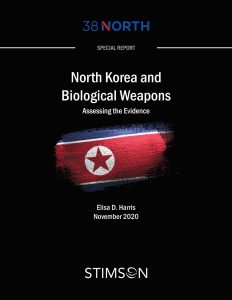North Korea and Biological Weapons: Assessing the Evidence
Executive Summary
 North Korea’s announcement that it is developing a vaccine for COVID-19 has focused renewed attention on Pyongyang’s purported biological weapons (BW) program. Over the past three years, three major news stories on the North Korean BW threat have been published in the United States, most recently by Politico in July 2020.
North Korea’s announcement that it is developing a vaccine for COVID-19 has focused renewed attention on Pyongyang’s purported biological weapons (BW) program. Over the past three years, three major news stories on the North Korean BW threat have been published in the United States, most recently by Politico in July 2020.
This report discusses what the two countries with the greatest security interests on the Korean Peninsula, the United States and the Republic of Korea, have said publicly on the issue over the past 20 years. It also examines whether the policy responses adopted by the two governments have been consistent with concerns that North Korea has an advanced BW program, as these media reports have claimed. Five themes emerge from this review:
- Many of the terms used by the US government in discussing the possibility that North Korea and other countries are developing or possess biological weapons are highly ambiguous. This is especially true of the term “biological warfare program,” which the US has used repeatedly for decades without ever defining what constitutes such a program. However, based on a definition by United Nations (UN) inspectors investigating Iraq’s BW activities, probably the most that can be said in the case of North Korea is that it may have or have had a BW program.
- There is a high degree of uncertainty about what the purported North Korean BW program actually entails. This is reflected in the many qualifications used by US government agencies in their public comments on the North Korean program. Even more uncertainty surrounds what is known, or what US officials are willing to say publicly, about actual North Korean stocks of biological weapons. The same uncertainty has been apparent in South Korean government reports on the North Korean BW threat over the last 14 years.
- There is a lack of consistency in the public assessments of the US and South Korean governments or between the assessments and the policy responses of those governments. The most striking US example of this is the inconsistency in the State Department’s unclassified arms control reports, which have gone from charging North Korea with having a mature offensive BW program to focusing for nearly a decade simply on the DPRK’s biological research and development (R&D) infrastructure to, more recently, repeating its BW accusations from 20 years earlier. South Korea, for its part, has gone from accusing North Korea of maintaining BW facilities and stocks to referring only to BW agents the DPRK is able or suspected of being able to develop and produce.
- There have been conflicting assessments between government agencies on the North Korean BW issue. For example, after 12 years of not mentioning the subject in the annual threat assessment testimony to Congress, in 2018, the director of national intelligence (DNI) reiterated earlier statements regarding the ability of North Korea’s biotechnology infrastructure to support a BW program. However, in 2019, the DNI said nothing on the subject, even as the State Department was charging North Korea with developing, producing and possibly weaponizing BW agents.
- Most importantly, the US government has finally acknowledged what has been clear for many years—that the US has only fragmented insight into North Korea’s BW capabilities and intentions. This is, in part, a reflection of the challenges posed by collecting intelligence on facilities, equipment and materials that can be used for both civilian and military purposes. Moreover, given the closed nature of North Korean society, it is unlikely that the US or South Korean governments would know without reliable sources on the ground whether North Korea has given BW development and production a high degree of priority.
In the final analysis, North Korea may once have had and may still be pursuing a biological weapons capability. It is also possible that North Korea never moved beyond R&D on biological agents and the establishment of a biotechnical infrastructure that could support future BW production. It is also possible that the North Korean program never moved beyond planning or, whatever its previous nature, the program has essentially ended. But one thing seems clear—nothing in the official public record to date indicates that North Korea has an advanced BW program, notwithstanding media reports to the contrary.
